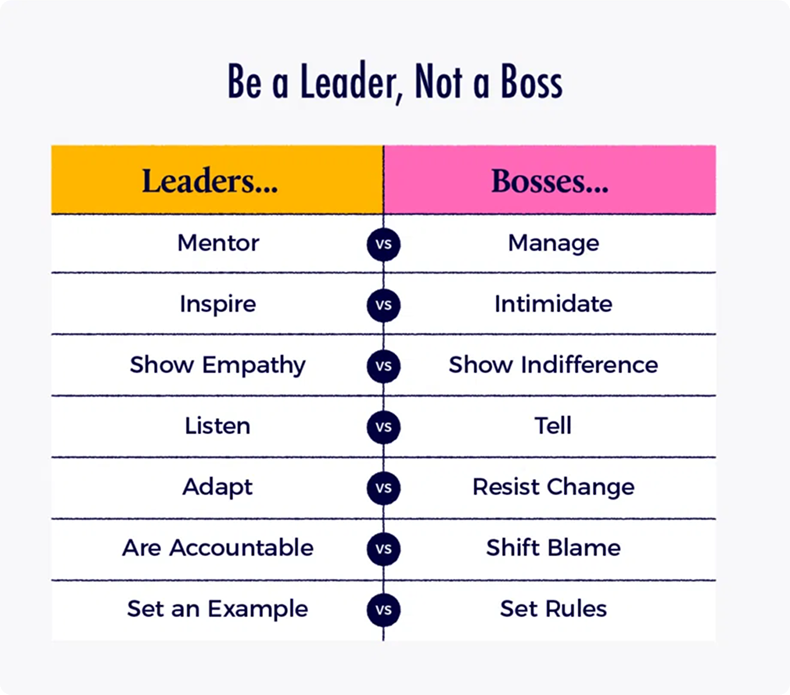10 Key Differences Between a Boss and a Leader

“Boss” and “leader” are often used interchangeably—but they mean very different things. One holds a position. The other earns it. One manages work. The other moves people.
A boss may demand results, but a leader inspires them. That difference can shape the culture of an entire organization—and directly affect whether teams thrive or burn out.
If you want to lead, not just manage, here are 10 key differences to understand and embody.

1. Authority vs. Influence
A boss relies on authority—granted by title or position—to direct tasks and enforce rules. This can lead to compliance, but not genuine engagement. People follow because they have to.
A leader, on the other hand, leads through influence—earned by trust, integrity, and emotional intelligence. Their team follows because they believe in the leader’s vision and values.
Authority may get short-term results. Influence creates long-term commitment. While a boss gives orders, a leader inspires ownership. The difference? One drives tasks. The other drives people.
2. Focus on Control vs. Empowerment
Bosses often prioritize control, believing that close oversight ensures consistent performance. They may require constant updates, dictate every step of a process, and hesitate to delegate. This approach can stifle creativity and hinder autonomy, leading to a culture where employees feel distrusted or undervalued.
Leaders take the opposite approach. Rather than exerting control over every detail, they empower their teams to make decisions, take initiative, and own their responsibilities. This doesn’t mean leaders are hands-off—it means they provide guidance, set clear expectations, and then trust their people to execute.
Empowerment leads to higher morale and innovation. When individuals feel trusted and supported, they’re more likely to take risks, solve problems independently, and develop professionally. It also frees up leaders to focus on strategy and vision, rather than getting caught in the weeds.
3. Managing People vs. Developing People
A boss focuses on managing people as resources—assigning tasks, tracking progress, and ensuring productivity. It’s about control and efficiency, often treating team members as interchangeable roles.
A leader looks beyond the task list. They invest in people’s growth, offering mentorship, feedback, and opportunities to stretch. They recognize potential and help individuals advance in their careers.
This shift from managing to developing builds stronger, more engaged teams. Employees feel valued not just for what they do now, but for who they can become. The result? Higher loyalty, better performance, and a culture built for long-term success.
4. Short-Term Results vs. Long-Term Vision
A boss often places heavy emphasis on immediate outcomes—meeting quarterly targets, hitting performance benchmarks, and delivering short-term gains. While results are undeniably important, this approach can lead to reactive decision-making, employee burnout, and missed opportunities for innovation. The focus becomes completing tasks rather than building a sustainable path forward.
Leaders balance short-term execution with a long-term perspective. They understand that real success isn’t measured only by what happens this month, but by how well the team is positioned for the future. Leaders invest in strategic planning, talent development, and culture-building. They prioritize growth over urgency, aiming to create systems and teams that are resilient and adaptable over time.
This long-term mindset fosters deeper engagement. Employees are more motivated when they see a clear vision and understand how their work contributes to a meaningful and enduring purpose.

5. Blame vs. Responsibility
Bosses often respond to problems by assigning blame, aiming to protect their image or control. This creates fear and shuts down innovation—employees avoid risk because mistakes are punished, not understood.
Leaders do the opposite: they take responsibility, even for team missteps. Instead of pointing fingers, they focus on what can be learned and improved. This builds a culture of shared accountability and psychological safety, where people feel free to speak up, take initiative, and grow.
When leaders own the outcome, teams step up with them—because responsibility inspires trust, while blame drives distance.
6. Fear-Based vs. Trust-Based Culture
A fear-based culture often emerges under bosses who rely on strict rules, punishment, and intimidation to maintain order. In this setting, employees may feel anxious about making mistakes or speaking up. Innovation is stifled because people are more concerned with self-preservation than creative thinking. The result is compliance rather than commitment.
Leaders build trust-based cultures where people feel psychologically safe. Trust is cultivated through transparency, consistency, and respect. Employees are encouraged to express their ideas, admit challenges, and take thoughtful risks without fear of ridicule or retaliation. This openness fosters creativity, accountability, and stronger relationships across the organization.
In a trust-based environment, teams thrive. Morale improves, productivity increases, and people feel more connected to their work and each other. Trust becomes the foundation for collaboration and sustainable performance.
Maximize productivity of your business
Track employee productivity and simplify work with them
7. Commands vs. Communication
Bosses tend to issue commands and expect compliance, often without explanation. While this can be efficient, it shuts down dialogue and limits engagement. Team members may follow orders, but they don’t feel heard or involved.
Leaders communicate with intent. They explain the “why,” listen actively, and invite input. This two-way communication fosters trust, clarity, and shared ownership.
When people understand not just what to do, but why it matters, they contribute more thoughtfully. Open communication strengthens collaboration, reduces confusion, and turns a group of individuals into a unified, purpose-driven team.
8. Status Quo vs. Innovation
Bosses tend to favor the status quo, often because it provides a sense of predictability and control. They may resist change, stick to rigid processes, or dismiss new approaches that deviate from “how things have always been done.” While consistency has its place, an overreliance on tradition can make teams stagnant and uncompetitive.
Leaders embrace innovation. They seek new ideas, experiment with fresh methods, and encourage their teams to challenge outdated systems. Rather than fearing change, they see it as essential to progress. They create an environment where experimentation is safe and failure is part of the learning process.
Innovation requires courage and flexibility, traits leaders cultivate in themselves and others. By supporting continuous improvement, they ensure their team or organization can adapt and thrive in an ever-evolving landscape.
9. Employees Work for the Boss vs. With the Leader
Bosses often position themselves above the team, treating employees as subordinates tasked with fulfilling their agenda. This top-down dynamic can create distance, dampen morale, and breed disengagement.
Leaders, in contrast, work with their team. They collaborate, share responsibility, and support others in reaching shared goals. They don’t delegate from a pedestal—they roll up their sleeves alongside everyone else.
This sense of partnership builds trust and loyalty. When people feel included and respected, they bring their best. Teams thrive when they’re led by someone who leads among them, not over them.

10. Job Title vs. Mindset
Being a boss is a title—something that comes with a promotion, role assignment, or position on an organizational chart. It signifies authority and responsibility, but it doesn’t automatically make someone a leader. Titles can be given, but leadership must be earned.
Leadership is a mindset. It’s defined by how you treat people, how you make decisions, and how you inspire others. A leader doesn’t rely on their job title to command respect; they demonstrate integrity, empathy, and vision every day. Leadership is about attitude, behavior, and impact—not hierarchy.
This distinction becomes clear in how others respond. People follow a title out of obligation, but they follow a true leader out of belief. In any organization, some of the most effective leaders may not even be at the top—they lead through influence, example, and character.
Why This Distinction Matters
The difference between being a boss and being a leader is more than semantics—it’s a defining factor in the success of teams and organizations. A boss may achieve short-term goals, but a leader creates lasting value. Leaders build strong cultures, retain top talent, and drive innovation through trust and collaboration.
In today’s work environment, where employees seek purpose, flexibility, and fulfillment, leadership is no longer optional—it’s essential. People don’t leave companies, they leave bad bosses. And they stay for great leaders who believe in them, challenge them, and help them grow.
Understanding and embracing this difference has a ripple effect: it elevates performance, improves morale, and strengthens organizational resilience.
How to Transition from Boss to Leader
Becoming a true leader requires conscious effort and self-reflection. Here are some ways to make that shift:
✅ Listen more than you speak. Invite ideas, feedback, and honest dialogue from your team.
✅ Empower others. Delegate meaningfully, trust your team’s judgment, and support their growth.
✅ Lead by example. Demonstrate the values, work ethic, and attitude you want others to embody.
✅ Invest in development. Provide coaching, resources, and opportunities for learning and advancement.
✅ Focus on the big picture. Balance daily performance with long-term team and organizational goals.
✅ Build trust. Be consistent, transparent, and reliable in your communication and decision-making.
✅ Practice humility. Own your mistakes, share credit, and keep learning—regardless of your title.
These changes don’t happen overnight, but each step away from a boss mindset and toward a leadership mindset creates lasting impact.
Conclusion: It’s About Trust
Leadership today isn’t about titles—it’s about trust. The era of command-and-control is giving way to something better: connection, clarity, and collaboration.
Bosses manage from above. Leaders work beside you. Bosses focus on output. Leaders build people who create real impact.
Authority can be given. Leadership is earned—through how you listen, how you communicate, and how you show up when it matters.
So the real question isn’t what position you hold. It’s this: Would your team choose to follow you—if they didn’t have to?
– The Monitask Team
FAQ: Differences Between a Boss and a Leader
What if my company culture supports traditional boss behavior—can I still be a leader?
Yes. Leadership is personal and doesn’t always require institutional support. Even within rigid environments, you can choose to model leadership behavior—communicating transparently, empowering your team, and focusing on development rather than control.
How can I tell if I’m leading or just managing?
Ask yourself: Are your team members growing, engaged, and confident enough to take initiative? Do they come to you with ideas, not just problems? Leaders develop people, create trust, and inspire action beyond the checklist.
What are some common mistakes bosses make when trying to lead?
Common missteps include over-controlling decisions, failing to listen, focusing solely on metrics, and neglecting emotional intelligence. Leadership requires vulnerability, adaptability, and a willingness to serve the team—not just direct it.
Can leadership skills be learned, or are they innate?
Leadership can absolutely be learned. While some people may have natural traits that align with leadership, most skills—such as active listening, emotional regulation, coaching, and strategic thinking—can be developed through practice and feedback.



